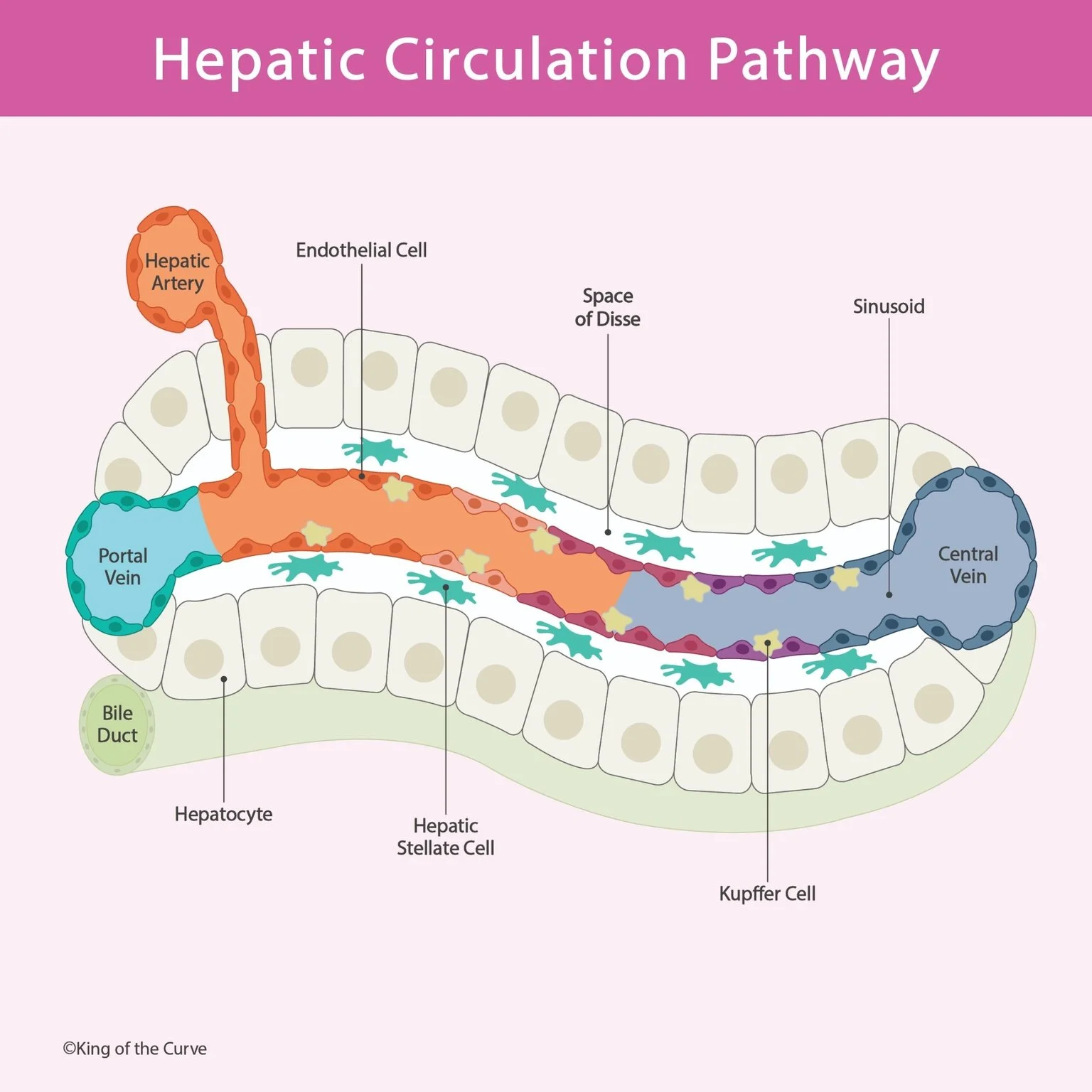🧠 Hepatic Circulation Pathway — What Flows Where
The liver’s dual blood supply and micro-architecture show up constantly on the MCAT (physiology, biochem, histology) and in NCLEX care plans for cirrhosis, portal hypertension, and TIPS. If you can visualize how portal blood and arterial blood mix in sinusoids and drain to the central vein, you can predict zone-specific injury, lab trends, and complications.
🏞️ Map of the hepatic lobule (from the portal triad to the central vein)
Portal triad = portal vein, hepatic artery, bile duct at the lobule periphery.
Sinusoids = low-pressure capillary channels where portal + arterial blood mix.
Endothelial fenestrations allow exchange across the space of Disse (between endothelium and hepatocytes).
Hepatocytes perform metabolism, detox, protein synthesis (albumin, clotting factors).
Kupffer cells (resident macrophages) line sinusoids—phagocytose bacteria, debris, old RBCs.
Hepatic stellate (Ito) cells in the space of Disse store vitamin A; when chronically injured, they activate → myofibroblasts → collagen deposition → fibrosis.
Flow direction: Blood goes from triad → central vein; Bile flows opposite in canaliculi → bile duct.
🧭 Zones you must know (and why)
Zone 1 (periportal) — closest to hepatic artery: best oxygen, handles oxidative metabolism, gluconeogenesis, and urea cycle.
Zone 2 (mid-zonal) — intermediate.
Zone 3 (centrilobular) — closest to central vein: lowest oxygen, highest CYP450; most vulnerable to ischemia and toxic injury.
Classic exam pairings
Acetaminophen toxicity → Zone 3 necrosis (CYP activity + low O₂).
Viral hepatitis often periportal (Zone 1) inflammation first.
Cardiac failure/shock → centrilobular (Zone 3) congestion/necrosis.
🚨 When the pathway breaks: clinical connections
Cirrhosis: Activated stellate cells lay down collagen in the space of Disse → sinusoidal resistance → portal hypertension (ascites, splenomegaly, varices).
TIPS (transjugular intrahepatic portosystemic shunt): Portal vein → hepatic vein bypass to lower portal pressure; trade-off is less first-pass clearance → higher risk of hepatic encephalopathy.
Budd–Chiari syndrome: Hepatic vein outflow obstruction → painful hepatomegaly, ascites, elevated LFTs.
Sepsis: Kupffer cells trigger cytokines; impaired detox → worsening encephalopathy.
NCLEX nursing pearls
Monitor for GI bleeding (varices), ascites (daily weights, abdominal girth), encephalopathy (ammonia-lowering therapy, lactulose), and coagulopathy (INR).
Post-TIPS: neuro checks, protein moderation, assess for encephalopathy.
🧪 High-yield quick table
| Structure | What flows | Core job | Exam hook |
|---|---|---|---|
| Portal vein | Nutrient-rich, deoxygenated blood | Brings gut products to liver | ↑ ammonia in failure → encephalopathy |
| Hepatic artery | Oxygen-rich blood | Feeds periportal hepatocytes | Zone 1 best O2; shock spares Zone 1 last |
| Sinusoid | Mixed portal + arterial blood | Exchange with hepatocytes | Site of Kupffer cells |
| Space of Disse | Plasma | Interface with hepatocyte microvilli | Stellate cells store vitamin A; fibrosis here |
| Central vein | Collected outflow | Drains to hepatic vein → IVC | Zone 3 ischemia/toxins |
| Bile duct | Bile (opposite to blood flow) | Excretes bile acids/bilirubin | Cholestasis labs (↑ ALP, GGT) |
🧠 MCAT mini-checks (answers below)
Which zone is most vulnerable in shock?
Why does TIPS increase risk of encephalopathy?
Which resident cells store vitamin A and drive fibrosis in chronic injury?
Keys: 1) Zone 3 (centrilobular). 2) It bypasses first-pass detox (ammonia → brain). 3) Hepatic stellate (Ito) cells.
🚀 Keep climbing the curve with KOTC
Daily warm-ups: kingofthecurve.org/qotd
Visual library: kingofthecurve.org/studyscience
Start free: kingofthecurve.org/free-lifetime
Premed hub: kingofthecurve.org/pre-med-essentials
Frequently Asked Questions (FAQs)
-
Aim for 4-6 focused hours, ensuring you incorporate breaks to avoid burnout.
-
Practice mindfulness techniques, take practice exams under realistic conditions, and maintain a balanced lifestyle.
-
Set short-term goals, seek support from mentors, and reward yourself for small achievements.
-
Regular exercise improves focus, reduces stress, and enhances overall mental clarity.
-
KOTC offers personalized learning tools, gamification features, and adaptive question banks to help students stay on track without burnout.


